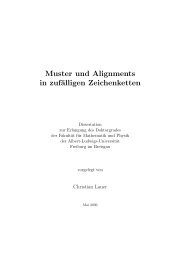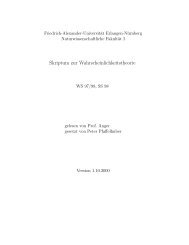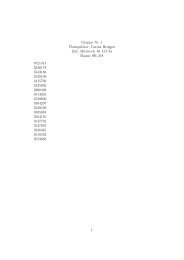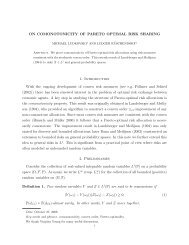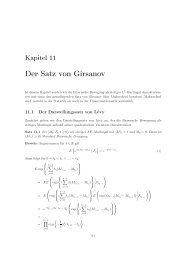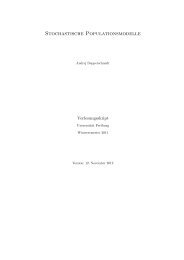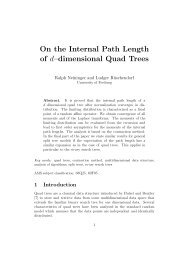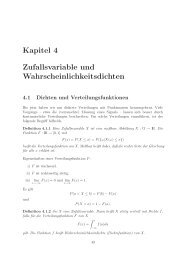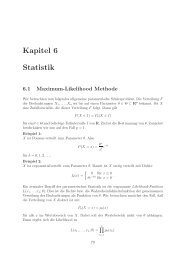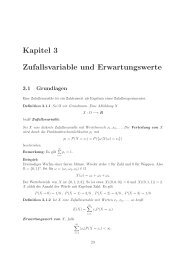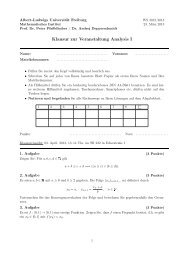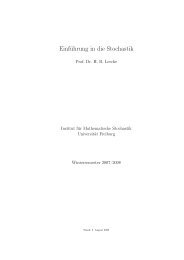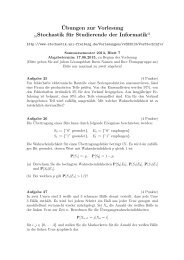Analysis of Markov chain algorithms on spanning trees, rooted ...
Analysis of Markov chain algorithms on spanning trees, rooted ...
Analysis of Markov chain algorithms on spanning trees, rooted ...
Create successful ePaper yourself
Turn your PDF publications into a flip-book with our unique Google optimized e-Paper software.
J. Fehrenbach and L. Rüschendorf 23<br />
Pro<str<strong>on</strong>g>of</str<strong>on</strong>g>: Let V E := {v e | e ∈ E} be a set <str<strong>on</strong>g>of</str<strong>on</strong>g> new nodes and define G ′′ := (V ′′ , E ′′ )<br />
with V ′′ := V ∪ V E , E ′′ := ⋃ e∈E<br />
{<br />
{v, ve } | v ∈ e } , i.e. the edge e = {v, w} is<br />
replaced by two edges {v, v e } and {w, v e }. For each node e ∈ E we denote <strong>on</strong>e<br />
endnode by e r as right endnode and <strong>on</strong>e endnode by e l as left endnode. For<br />
X ∈ ST (G ′′ ) the subset A := { e ∈ E | {v e , e r } ∈ X } is a c<strong>on</strong>nected <strong>spanning</strong><br />
subgraph <str<strong>on</strong>g>of</str<strong>on</strong>g> G. Further, T := { e ∈ E | {v e , e r } ∈ X and {v e , e l } ∈ X } is a<br />
<strong>spanning</strong> tree <str<strong>on</strong>g>of</str<strong>on</strong>g> G.<br />
C<strong>on</strong>versely X can be rec<strong>on</strong>structed from A and T since<br />
X = { {v e , e r } | e ∈ A } ∪ { {v e , e l } | e ∈ T ∪ (E\A) } .<br />
Thus this mapping is bijective.<br />
✷<br />
Thus any A ∈ S c (G) corresp<strong>on</strong>ds to as many <strong>spanning</strong> <strong>trees</strong> <str<strong>on</strong>g>of</str<strong>on</strong>g> G ′′ as A has<br />
itself. We introduce as in secti<strong>on</strong> 5 a weighting <strong>on</strong> ST (G ′′ ) by<br />
‖X‖ := |A| (6.1)<br />
where X ∈ ST (G ′′ ) corresp<strong>on</strong>ds to (A, T ) in Lemma 6.1.<br />
Definiti<strong>on</strong> 6.2 (<str<strong>on</strong>g>Markov</str<strong>on</strong>g> <str<strong>on</strong>g>chain</str<strong>on</strong>g> <strong>on</strong> ST (G ′′ )) We define for λ ∈ IR + the<br />
<str<strong>on</strong>g>Markov</str<strong>on</strong>g> <str<strong>on</strong>g>chain</str<strong>on</strong>g> M λ S c<br />
(G ′′ ) = (X t ) <strong>on</strong> ST (G ′′ ) as in Definiti<strong>on</strong> 5.3 where the<br />
norm ‖X‖ is defined by (6.1).<br />
Similarly to the argument in secti<strong>on</strong> 5 we obtain (for details <str<strong>on</strong>g>of</str<strong>on</strong>g> the argument<br />
see Fehrenbach (2003))<br />
Theorem 6.3 The <str<strong>on</strong>g>Markov</str<strong>on</strong>g> <str<strong>on</strong>g>chain</str<strong>on</strong>g> M S λ c<br />
(G ′′ ) is ergodic for any λ ∈ IR + with<br />
stati<strong>on</strong>ary distributi<strong>on</strong><br />
π λ<br />
(X) := λ‖X‖<br />
Z(λ)<br />
with Z(λ) := ∑<br />
X∈ST (G ′ )<br />
for X ∈ ST (G ′′ ). The mixing time τ λ is bounded by<br />
λ ‖X‖ (6.2)<br />
τ λ (ε) ≤ 2n 2 mλ ′ (n log(mλ ′ ) + log ε −1 ), (6.3)<br />
for all ε ∈ (0, 1) with λ ′ := max{λ, λ −1 }, n := |V ′′ | and m := |E ′′ |.<br />
Based <strong>on</strong> Lemma 6.1 we can transfer the <str<strong>on</strong>g>Markov</str<strong>on</strong>g> <str<strong>on</strong>g>chain</str<strong>on</strong>g> M λ S c<br />
(G ′′ ) <strong>on</strong> the<br />
basic space ⋃ A∈S {(A, T ); T ∈ ST (A)} and project it <strong>on</strong> S c(G) c(G). Then we<br />
obtain a <str<strong>on</strong>g>Markov</str<strong>on</strong>g> <str<strong>on</strong>g>chain</str<strong>on</strong>g> M λ S c<br />
(G) <strong>on</strong> S c (G). The weight <str<strong>on</strong>g>of</str<strong>on</strong>g> a state A ∈ S c (G)<br />
w.r.t. its stati<strong>on</strong>ary distributi<strong>on</strong> is given by λ |A|<br />
|ST (A)|. The rapid mixing<br />
property remains the same since the number <str<strong>on</strong>g>of</str<strong>on</strong>g> edges and nodes <str<strong>on</strong>g>of</str<strong>on</strong>g> G and G ′′<br />
<strong>on</strong>ly differ by a polynomial factor. Thus we obtain<br />
Corollary 6.4 The <str<strong>on</strong>g>Markov</str<strong>on</strong>g> <str<strong>on</strong>g>chain</str<strong>on</strong>g> M λ S c<br />
(G) induced by M λ S c<br />
(G ′′ ) <strong>on</strong> S c (G) is<br />
rapidly mixing with stati<strong>on</strong>ary distributi<strong>on</strong><br />
π λ (A) = λ |A| |ST (A)|, A ∈ S c (G). (6.4)



